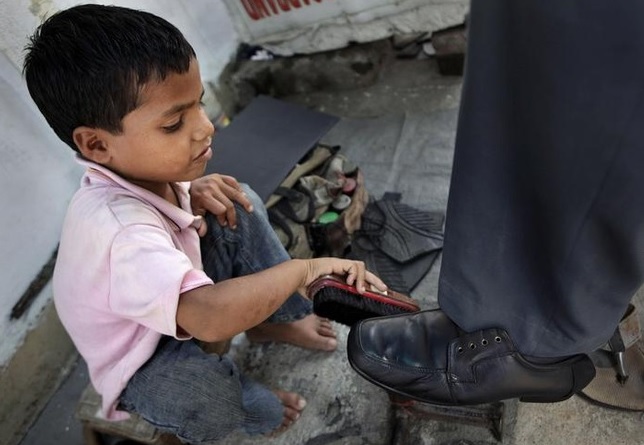With an officially estimated 12.6 million children engaged in hazardous occupations (2001 Census), India has the largest number of child labourers under the age of 14 in the world

What is Child Labour?
Employing children for economic activity under age (say 5-14 year olds) is defined as child labour. The actual higher limit of age is defined by the legal systems in individual countries and can vary with the legal ‘minimum age’ laws. Needless to say, children already working at such young ages rarely have the childhoods that we crave for as grown ups. Child labour has a negative impact on both their mental and physical states. The worst forms of child labour include slavery, trafficking and prostitution.
India has enacted several laws against the practice of child labour. Some of these include:
- Factories Act, 1948 – Prohibition of employment of children below the age of 14 in any factory. Rules set on who, when and how long can children between 15–18 years be employed in any factory.
- Mines Act of 1952 – Prohibition of employment of children below 18 years of age in mines
- Child Labour (Prohibition and Regulation) Act, 1986 – Prohibition of employment of children below the age of 14 years in hazardous occupations identified in a list (expanded in 2006 & 2008)
- Juvenile Justice (Care and Protection) of Children Act, 2000 – Employment of a child in any hazardous employment or in bondage defined as crime, punishable with a prison term,
- Right of Children to Free and Compulsory Education Act, 2009 – Free and compulsory education to all children aged 6 to 14 years. 25% seats in every private school allocated for children from disadvantaged groups (including physically challenged)
- Following RTE of 2009, all forms of labour for children under 14 is banned in India. And if found guilty can result in a prison term as well as a fine.
And yet here are additional statistics surround Child Labour in India, which are disheartening to say the least.
- 12.6 million children working as child labour (2001 Indian census). Out of these 12 million engaged in hazardous jobs (e.g. working in mines, working with chemicals and pesticides in agriculture or working with dangerous machinery)
- A 2011 Unicef report accounted for 28 million child labourers in India. The report further stated that Gujarat has the highest proportion of children working (30%), Kerala has the least (3%). The census report states a different set of states, but then this is really not the best competition to be number one.
- Agriculture sector employs over 50% child labourers, but it is very common to have child labour in the unorganised sectors. Prominent sectors include: Bidi Making, Carpet Industry, Garages, Domestic Work, Farming, Construction & Cement Industries, Tea Stalls, Fireworks Industry, Diamond Making, Shoe Polishing etc.
- Rural children are more likely to be engaged in work (>12%) compared to urban counterparts
There the multiple reasons on why this issue exists. But the one we wanted to highlight was the one each of us sees and ignores. The multiple number of times we eat at restaurants on the highway, or get our shirts ironed, or have domestic help (even if to take care of children) as essentially young children, we need to realise the crime that we are committing by being a party to this and stealing someone’s childhood. The next time you see Chotu or Pinky, it’s important to remember this.
Disclaimer: The numbers are from the agencies mentioned, and MIEF does not hold any expertise over them, we are sharing these for the purpose of awareness.
Read more: Wikipedia, FT story, UNICEF report, Ministry of statistics report
One thought on “Child Labour In India: An overview”